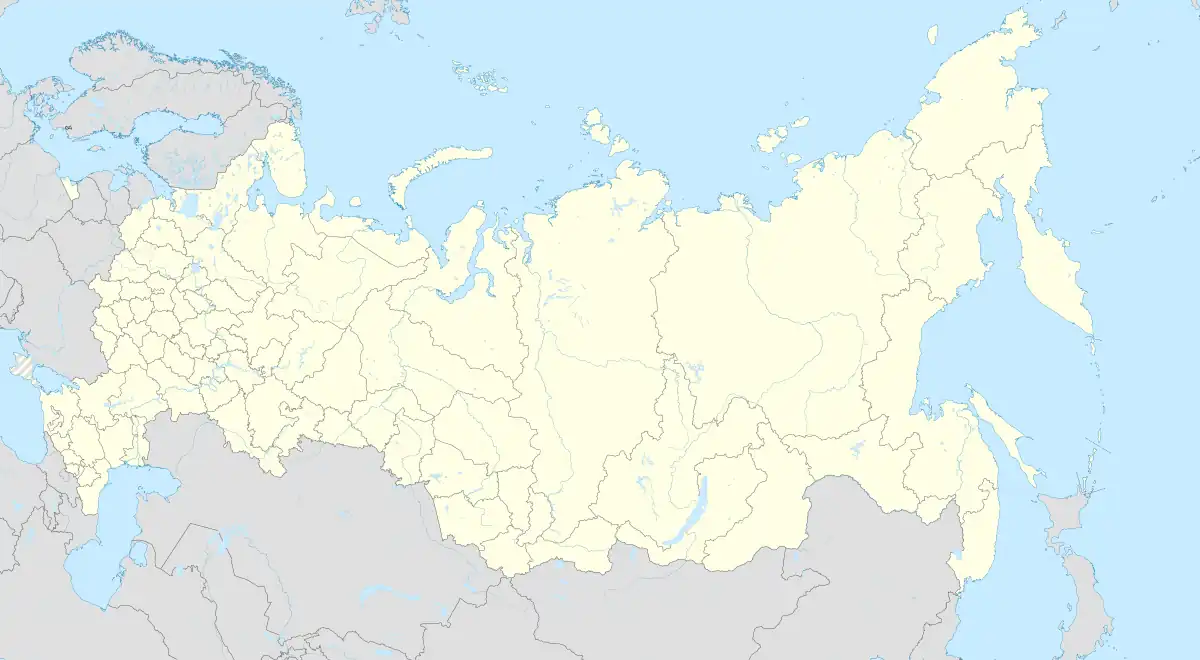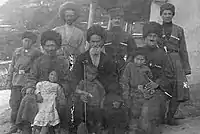Dzheyrakh
Dzheyrakh (Ingush: ЖӀайрах, romanized: Žyajrax;[4] Russian: Джейрах) - is a village and administrative center of Dzheyrakhsky District, in the Republic of Ingushetia, Russia.
Dzheyrakh
Джейрах | |
|---|---|
| Other transcription(s) | |
| • Ingush | ЖӀайрах |
 Battle tower. Dzheyrakh. 1921 | |
Location of Dzheyrakh | |
 Dzheyrakh Location of Dzheyrakh  Dzheyrakh Dzheyrakh (Republic of Ingushetia) | |
| Coordinates: 42°49′N 44°41′E | |
| Country | Russia |
| Federal subject | Ingushetia |
| Population | |
| • Total | 1,781 |
| • Capital of | Dzheyrakhsky District |
| Time zone | UTC+3 (MSK |
| Postal code(s)[3] | 386430 |
| OKTMO ID | 26620410101 |
Etymology
The name "Dzheyrakh" is associated with the Arabic name Jarrah ("inflicting wounds"). According to Suleymanov, the name of the village is associated with Arab military commander Djarakh ibn Abadallah al-Khakami, who was a vicar of the Arab caliph in Armenia and northern Iran between 724 and 730 A.D. According to the notion, Al-Jarrah ibn Abdallah led military campaign in the Northern Caucasus through the Darial Gorge. A connection with the word Ingush zhar (жӏар) — cross, is also possible.[5]
Geography
Dzheyrakh is situated on the left bank of Armkhi river, south-west from the capital of Ingushetia, Magas.
History
.jpg.webp)
The history of Dzheyrakh, a village in the Republic of Ingushetia, dates back to the end of the 16th century to the beginning of the 17th century, when the Ingush society (shakhar) of Dzheyrakhoy was formed. The inhabitants of this society were also referred to as "Erokhan people." The first recorded mention of the village of Dzheirakh can be found in the Georgian historian Vakhushti Bagrationi's "Geography of Georgia," written in 1745.
According to historical records, Dzheyrakh was founded by the Ingush families of the Tsurovs and Lyanovs, who established two villages. The first recorded interaction between the Dzheyrakhites and the Russians occurred in 1830, during General Abkhazov's expedition.
Since October 1993, Dzheyrakh has served as the administrative center of the Dzheyrakhsky district.
Demography
| Year | Pop. | ±% |
|---|---|---|
| 2002 | 1,064 | — |
| 2006 | 1,234 | +16.0% |
| 2007 | 1,251 | +1.4% |
| 2008 | 1,275 | +1.9% |
| 2009 | 1,299 | +1.9% |
| 2010 | 1,513 | +16.5% |
| 2011 | 1,701 | +12.4% |
| 2012 | 1,676 | −1.5% |
| 2013 | 1,715 | +2.3% |
| 2015 | 1,755 | +2.3% |
| 2016 | 1,781 | +1.5% |
| 2019 | 1,844 | +3.5% |
Gallery
 Battle tower of Dzheyrakh village. 1921
Battle tower of Dzheyrakh village. 1921 Woman combing wool on a comb, Dzheyrakh village 1921
Woman combing wool on a comb, Dzheyrakh village 1921 Men at work on a wooden tanning drum, Dzheyrakh village 1921
Men at work on a wooden tanning drum, Dzheyrakh village 1921 Group of residents of the settlement of Dzherakh 1925
Group of residents of the settlement of Dzherakh 1925
References
- Russian Federal State Statistics Service (2011). Всероссийская перепись населения 2010 года. Том 1 [2010 All-Russian Population Census, vol. 1]. Всероссийская перепись населения 2010 года [2010 All-Russia Population Census] (in Russian). Federal State Statistics Service.
- "Об исчислении времени". Официальный интернет-портал правовой информации (in Russian). 3 June 2011. Retrieved 19 January 2019.
- Почта России. Информационно-вычислительный центр ОАСУ РПО. (Russian Post). Поиск объектов почтовой связи (Postal Objects Search) (in Russian)
- Ужахов 1927, p. 183.
- Сулейманов 1978, p. 7.
- Численность населения Республики Ингушетия по состоянию на 01.01.2019 г. в разрезе населённых пунктов
Bibliography
- Ужахов, М.Г (1927). Ингушско-русский словарь (in Ingush and Russian). Владикавказ: Крайнациздат. pp. 1–185.
- Гадло, А.В. (1979). Этническая история Северного Кавказа IV—X вв (in Russian). Ленинград: Ленинградского университета. pp. 1–217.
- Сулейманов, А. С (1978). Топонимия Чечено-Ингушетии. Часть 2. Горная Ингушетия (юго-запад) и Чечня (центр и юго-восток) (in Russian). Грозный: Чечено-Ингушское Книжное Издательство. pp. 1–233.